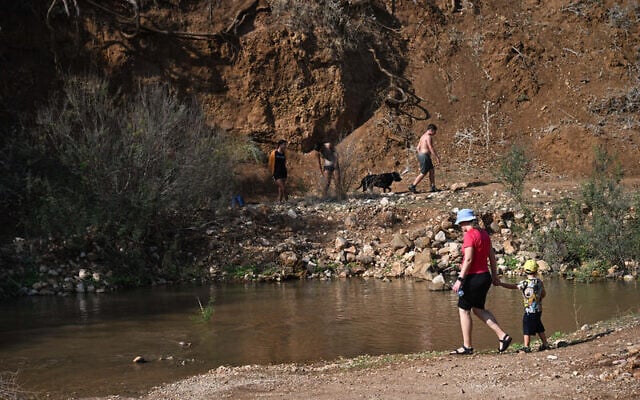Finding Value in Wastewater – KSAL News
Report on an Innovative Livestock Wastewater Treatment Initiative and its Contribution to Sustainable Development Goals
1.0 Project Overview
A multi-institutional research initiative, led by Kansas State University, is underway to address critical resource challenges in the High Plains region. The four-year, $6 million project focuses on converting livestock wastewater into reusable resources, directly contributing to the conservation of the Ogallala Aquifer and advancing several United Nations Sustainable Development Goals (SDGs). The collaboration involves experts in engineering, agricultural economics, and social sciences from Kansas State University, the University of Nebraska-Lincoln, Oklahoma State University, and Seward County Community College, exemplifying the multi-stakeholder partnerships essential for achieving the SDGs (SDG 17).
2.0 Core Technology and Sustainable Innovation
The project’s central technology is an anaerobic membrane bioreactor designed to treat livestock wastewater. This innovative system supports a circular economy model within agricultural operations by achieving three primary outcomes:
- Treating wastewater to a quality suitable for reuse in livestock systems.
- Recovering valuable nutrients for agricultural application.
- Generating biogas as a source of renewable, on-farm energy.
This approach directly supports SDG 9 (Industry, Innovation, and Infrastructure) by developing resilient and sustainable infrastructure for a key industry.
3.0 Direct Contributions to Sustainable Development Goals (SDGs)
The initiative is strategically aligned with multiple SDGs, creating a synergistic impact on environmental, social, and economic sustainability.
- SDG 6: Clean Water and Sanitation: By reducing the reliance on freshwater from the Ogallala Aquifer and treating wastewater, the project directly addresses targets for improving water quality, increasing water-use efficiency, and implementing integrated water resources management.
- SDG 7: Affordable and Clean Energy: The generation of biogas provides a renewable energy source, reducing operational reliance on fossil fuels and contributing to clean energy access on farms.
- SDG 12: Responsible Consumption and Production: The project epitomizes sustainable production patterns by transforming waste into valuable resources. It promotes the efficient use of natural resources (water) and encourages the adoption of sustainable practices within the livestock industry.
- SDG 2: Zero Hunger: By enhancing the long-term sustainability of livestock operations and recovering nutrients that can be used to improve soil health, the project supports resilient and sustainable food production systems.
- SDG 13: Climate Action: Capturing biogas mitigates the release of methane, a potent greenhouse gas, from manure lagoons, thereby contributing to climate change mitigation efforts.
4.0 Economic Feasibility and Adoption Strategy
A key focus of the project is ensuring the economic viability of the technology to encourage widespread adoption by producers. Researchers are analyzing how to add value to the treated wastewater and recovered nutrients, creating economic incentives that complement the environmental benefits. This aligns with SDG 12 by demonstrating that sustainable practices can also be profitable.
Factors influencing producer adoption include:
- The current cost and logistics of water acquisition.
- The potential for future policy and financial incentives for sustainable technologies.
- The ability to integrate the system seamlessly into existing operations.
5.0 Conclusion: A Model for Sustainable Agriculture
This research project provides a comprehensive model for balancing environmental stewardship with economic profitability in modern agriculture. By creating a closed-loop system for water, nutrients, and energy, the initiative offers a scalable solution to protect vital water resources like the Ogallala Aquifer. The collaborative effort underscores the importance of integrating technology, economic analysis, and policy to advance regional sustainability and make a tangible impact on the global Sustainable Development Goals.
Analysis of Sustainable Development Goals in the Article
1. Which SDGs are addressed or connected to the issues highlighted in the article?
-
SDG 6: Clean Water and Sanitation
- The core of the project is to treat livestock wastewater and turn it into a reusable resource, directly addressing water quality and availability. The article states, “The crux of what we’re doing is about water access,” and aims to “conserve the Ogallala Aquifer.”
-
SDG 7: Affordable and Clean Energy
- The technology described in the article includes “generating biogas for on-farm energy,” which contributes to the creation of renewable energy from waste products.
-
SDG 2: Zero Hunger
- The project focuses on strengthening the sustainability of livestock operations, which are a key part of food production systems. By making these operations more efficient and environmentally friendly, it supports sustainable agriculture.
-
SDG 12: Responsible Consumption and Production
- The article highlights the efficient management of waste and resources. The project aims to “manage waste more efficiently” by treating wastewater, recovering nutrients, and reusing water, which aligns with sustainable production patterns.
-
SDG 17: Partnerships for the Goals
- The project is a collaborative effort involving multiple institutions: “K-State, the University of Nebraska-Lincoln, Oklahoma State University and Seward County Community College.” It also emphasizes that “collaboration between researchers, producers, and policymakers will be critical.”
2. What specific targets under those SDGs can be identified based on the article’s content?
-
Target 6.3: By 2030, improve water quality by reducing pollution, eliminating dumping and minimizing release of hazardous chemicals and materials, halving the proportion of untreated wastewater and substantially increasing recycling and safe reuse globally.
- The project’s use of an “anaerobic membrane bioreactor that treats wastewater from livestock operations so that it can be reused” directly addresses this target.
-
Target 6.4: By 2030, substantially increase water-use efficiency across all sectors and ensure sustainable withdrawals and supply of freshwater to address water scarcity.
- The project’s goal to “reduce freshwater use” and “conserve the Ogallala Aquifer” by creating a process to “polish and clean water up enough so that it can be reused in the livestock system” aligns with this target.
-
Target 7.2: By 2030, increase substantially the share of renewable energy in the global energy mix.
- The technology’s capability of “generating biogas for on-farm energy” contributes to increasing the share of renewable energy, specifically within the agricultural sector.
-
Target 2.4: By 2030, ensure sustainable food production systems and implement resilient agricultural practices that increase productivity and production, that help maintain ecosystems, that strengthen capacity for adaptation to climate change, extreme weather, drought, flooding and other disasters and that progressively improve land and soil quality.
- The project aims to “strengthen sustainability across the High Plains” by introducing a technology that allows livestock operations to manage resources like water and nutrients more efficiently, making them more resilient and sustainable.
-
Target 12.5: By 2030, substantially reduce waste generation through prevention, reduction, recycling and reuse.
- The entire initiative is centered on turning “livestock wastewater into a reusable resource,” which involves recovering nutrients and reusing water, thereby reducing waste.
3. Are there any indicators mentioned or implied in the article that can be used to measure progress towards the identified targets?
-
Proportion of wastewater safely treated and reused:
- The article’s focus on a technology that “treats wastewater from livestock operations so that it can be reused” implies that a key metric for success would be the volume or percentage of wastewater that is successfully treated and reintegrated into the livestock system.
-
Reduction in freshwater use:
- The goal to “conserve the Ogallala Aquifer” and “reduce freshwater use” suggests that a measurable indicator would be the decrease in the amount of fresh water pumped from the aquifer for livestock operations that adopt this technology.
-
Amount of renewable energy generated:
- The mention of “generating biogas for on-farm energy” points to a quantifiable indicator: the volume of biogas produced and utilized as an energy source by the farms.
-
Adoption rate of sustainable technology by producers:
- The article discusses the importance of making the technology feasible so it becomes “more widely adopted.” Therefore, the number or percentage of livestock producers who integrate this system into their operations would be a direct indicator of progress.
-
Amount of nutrients recovered:
- The process involves “pulling in those carbon and nutrient elements to try and add value.” An indicator would be the quantity of nutrients (like nitrogen and phosphorus) recovered from the wastewater, which can then be repurposed.
4. Summary Table of SDGs, Targets, and Indicators
| SDGs | Targets | Indicators |
|---|---|---|
| SDG 6: Clean Water and Sanitation | 6.3: Improve water quality and increase safe reuse of wastewater. 6.4: Increase water-use efficiency and reduce water scarcity. |
– Proportion of livestock wastewater safely treated and reused. – Reduction in freshwater withdrawal from the Ogallala Aquifer. |
| SDG 7: Affordable and Clean Energy | 7.2: Increase the share of renewable energy. | – Amount of biogas generated and used for on-farm energy. |
| SDG 2: Zero Hunger | 2.4: Ensure sustainable food production systems and resilient agricultural practices. | – Adoption rate of the wastewater treatment technology by livestock producers. |
| SDG 12: Responsible Consumption and Production | 12.5: Substantially reduce waste generation through reuse and recycling. | – Amount of nutrients recovered from wastewater. |
| SDG 17: Partnerships for the Goals | 17.16: Enhance multi-stakeholder partnerships. | – Number of collaborative partnerships between universities, producers, and policymakers. |
Source: ksal.com
What is Your Reaction?
 Like
0
Like
0
 Dislike
0
Dislike
0
 Love
0
Love
0
 Funny
0
Funny
0
 Angry
0
Angry
0
 Sad
0
Sad
0
 Wow
0
Wow
0
















































:focal(1500,1000)/https://media.globalcitizen.org/a6/9a/a69a4720-d8a1-4715-b596-18738d03c05c/rotary_polio_hero_image.jpg?#)







/countries/sri-lanka/photo-credit---dmc-sri-lanka.tmb-1200v.jpg?sfvrsn=dc298bcc_1#)



















